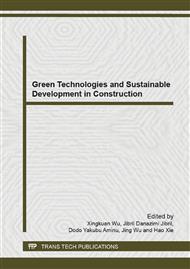[1]
RM. Pulselli, E. Simoncini, S. Bastianoni, Emergy analysis of building manufacturing, maintenance and use: em-building indices to evaluate housing sustainability, Energy and Buildings, 39(5), 2007, 620–8.
DOI: 10.1016/j.enbuild.2006.10.004
Google Scholar
[2]
C. Nelson, J. Roberts, a bay friendly landscape guide to recycled-content and salvaged materialas, Stop Waste agency, Alameda county, March (2009).
Google Scholar
[3]
B. Whiteside, Recycled Landscape Materials: Should the Average Homeowner Use Them?, University of Californiam, June 15, (2007).
Google Scholar
[4]
S.L. Huang, W.L. Hsu, Materials flow analysis and emergy evaluation of Taipei's urban construction, Landscape and Urban Planning, Volume 63, Issue 2, 15 April 2003, Pages 61-74.
DOI: 10.1016/s0169-2046(02)00152-4
Google Scholar
[5]
Information on http: /www. environment-agency. gov. uk/business/regulation/129223. aspx.
Google Scholar
[6]
L. R. de Rezende, J. C. de Carvalho, The use of quarry waste in pavement construction, Resources, Conservation and Recycling, Volume 39, Issue 1, August 2003, Pages 91-105.
DOI: 10.1016/s0921-3449(02)00123-4
Google Scholar
[7]
F. Hernández-Olivares, G. Barluenga, B. Parga-Landa, M. Bollati, B. Witoszek, Fatigue behaviour of recycled tyre rubber-filled concrete and its implications in the design of rigid pavements, Construction and Building Materials, Volume 21, Issue 10, October 2007, Pages 1918-(1927).
DOI: 10.1016/j.conbuildmat.2006.06.030
Google Scholar
[8]
A. Eller, R. Olson, Recycled Pavements Using Foamed Asphalt in Minnesota, Office of Materials & Road Research, February (2009).
Google Scholar
[9]
http: /fivegallonideas. com/fence-or-wall.
Google Scholar
[10]
http: /www. decoradvisor. net/decoration-ideas/ unoffending-fencing-successful-both-privacy-and-peers-in-excess-of-with-lovely-outside-fencing.
Google Scholar
[11]
http: /www. greenbuildingadvisor. com/ blogs/dept/design-matters/innovative-recycled-content-furnishings.
Google Scholar
[12]
http: /inhabitat. com/radiator-lounge-a-crazy-chair-made-from-recycled-radiators.
Google Scholar
[13]
http: /dishfunctionaldesigns. blogspot. nl/ 2012/05/upcycled-garden-using-recycled-salvaged. html.
Google Scholar
[14]
A. R. Lamborn, Recycling in the Garden, Environmental Horticulture Agent, (2010).
Google Scholar


